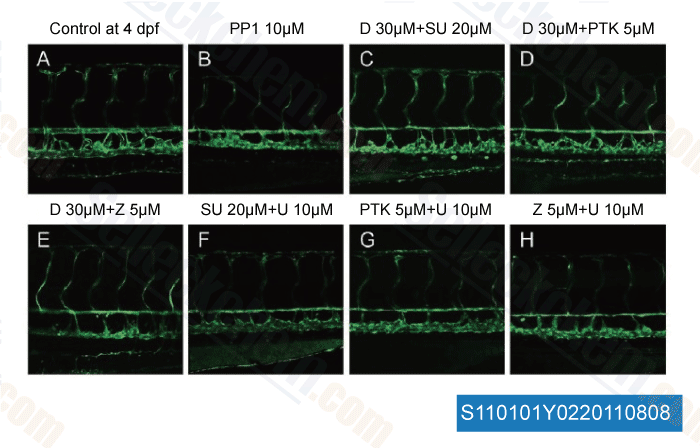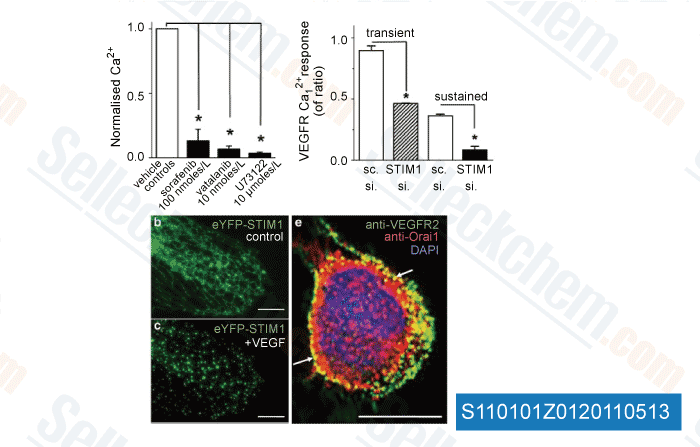|
Toll Free: (877) 796-6397 -- USA and Canada only -- |
Fax: +1-832-582-8590 Orders: +1-832-582-8158 |
Tech Support: +1-832-582-8158 Ext:3 Please provide your Order Number in the email. |
Technical Data
| Formula | C20H15ClN4.2HCl |
|||
| Molecular Weight | 419.73 | CAS No. | 212141-51-0 | |
| Solubility (25°C)* | In vitro | DMSO | 85 mg/mL (202.51 mM) | |
| Water | 10 mg/mL (23.82 mM) | |||
| Ethanol | 6 mg/mL (14.29 mM) | |||
|
* <1 mg/ml means slightly soluble or insoluble. * Please note that Selleck tests the solubility of all compounds in-house, and the actual solubility may differ slightly from published values. This is normal and is due to slight batch-to-batch variations. * Room temperature shipping (Stability testing shows this product can be shipped without any cooling measures.) |
||||
Preparing Stock Solutions
Biological Activity
| Description | Vatalanib 2HCl (PTK787, ZK 222584, cpg-79787) is an inhibitor of VEGFR2/KDR with IC50 of 37 nM in a cell-free assay, less potent against VEGFR1/Flt-1, 18-fold against VEGFR3/Flt-4. Phase 3. | |||||||||||
|---|---|---|---|---|---|---|---|---|---|---|---|---|
| Targets |
|
|||||||||||
| In vitro | Vatalanib also inhibits Flk, c-Kit and PDGFRβ with IC50 of 270 nM, 730 nM and 580 nM, respectively. Furthermore, Vatalanib shows the anti-proliferation effect by inhibiting thymidine incorporation induced by VEGF in HUVECs with and IC50 of 7.1 nM, and dose-dependently suppresses VEGF-induced survival and migration of endothelial cells in the same dose range without cytotoxic or antiproliferative effect on cells that do not express VEGF receptors. [1] A recent study shows that Vatalanib significantly inhibits the growth of hepatocellular carcinoma cells and enhances the IFN/5-FU induced apoptosis by increasing proteins levels of Bax and reduced Bcl-xL and Bcl-2. [2] | |||||||||||
| In vivo | Vatalanib induces dose-dependent inhibition of the angiogenic response to VEGF and PDGF in both a growth factor implant model and a tumor cell-driven angiogenesis model after once-daily oral dosing (25-100 mg/kg). In the same dose range, Vatalanib also inhibits the growth and metastasesof several human carcinomas in nude mice without significant effect on circulating blood cells or bone marrow leukocytes. [1] |
Protocol (from reference)
| Kinase Assay:[1] |
|
|---|---|
| Cell Assay:[1] |
|
| Animal Study:[1] |
|
References
|
Customer Product Validation

-
Data from [Data independently produced by Development, 2013, 140, 4323-34]

-
Data from [Cell Res, 2011, 21, 1080-1087]

-
Data from [Circ Res, 2011, 108, 1190-1198]
Selleck's Vatalanib (PTK787) 2HCl has been cited by 51 publications
| Platform combining statistical modeling and patient-derived organoids to facilitate personalized treatment of colorectal carcinoma [ J Exp Clin Cancer Res, 2023, 42(1):79] | PubMed: 37013646 |
| Inhibition of VEGFR2 and EGFR signaling cooperatively suppresses the proliferation of oral squamous cell carcinoma [ Cancer Med, 2023, 12(15):16416-16430] | PubMed: 37341071 |
| Inhibition of VEGFR2 and EGFR signaling cooperatively suppresses the proliferation of oral squamous cell carcinoma [ Cancer Med, 2023, 12(15):16416-16430] | PubMed: 37341071 |
| Investigation of the pharmacological effect and mechanism of mountain-cultivated ginseng and garden ginseng in cardiovascular diseases based on network pharmacology and zebrafish experiments [ Front Pharmacol, 2022, 13:920979] | PubMed: 36120313 |
| In Vitro Angiogenesis Inhibition and Endothelial Cell Growth and Morphology [ Int J Mol Sci, 2022, 23(8)4277] | PubMed: 35457095 |
| Establishment and Characterization of NCC-PMP1-C1: A Novel Patient-Derived Cell Line of Metastatic Pseudomyxoma Peritonei [ J Pers Med, 2022, 12(2)258] | PubMed: 35207746 |
| Establishment and characterization of NCC-UPS4-C1: a novel cell line of undifferentiated pleomorphic sarcoma from a patient with Li-Fraumeni syndrome [ Hum Cell, 2022, 10.1007/s13577-022-00671-y] | PubMed: 35118583 |
| Prognostic Analysis of LncRNA MCM3AP-AS1 in Colorectal Cancer and the Mechanism of Its Effect on Tumor Cell Activity [ Biomed Res Int, 2022, 2022:1616370] | PubMed: 36172487 |
| Rational application of gefitinib in NSCLC patients with sensitive EGFR mutations based on pharmacokinetics and metabolomics [ Acta Pharmacol Sin, 2021, 10.1038/s41401-021-00791-5] | PubMed: 34737420 |
| Establishment and characterization of novel patient-derived cell lines from giant cell tumor of bone [ Hum Cell, 2021, 10.1007/s13577-021-00579-z] | PubMed: 34304386 |
RETURN POLICY
Selleck Chemical’s Unconditional Return Policy ensures a smooth online shopping experience for our customers. If you are in any way unsatisfied with your purchase, you may return any item(s) within 7 days of receiving it. In the event of product quality issues, either protocol related or product related problems, you may return any item(s) within 365 days from the original purchase date. Please follow the instructions below when returning products.
SHIPPING AND STORAGE
Selleck products are transported at room temperature. If you receive the product at room temperature, please rest assured, the Selleck Quality Inspection Department has conducted experiments to verify that the normal temperature placement of one month will not affect the biological activity of powder products. After collecting, please store the product according to the requirements described in the datasheet. Most Selleck products are stable under the recommended conditions.
NOT FOR HUMAN, VETERINARY DIAGNOSTIC OR THERAPEUTIC USE.
